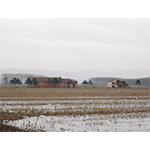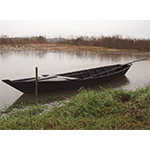Fucecchio Marshes Nature Reserve
Belonging since the early 14th century to the Republic of Lucca, the lake-marshes of Fucecchio, surrounded by the Pisan Mountains, Monte Albano and the hills of Cerreto Guidi, became the property of the Republic of Florence in 1328. After partial land reclamation projects had been carried out, in 1549 Cosimo I de' Medici commissioned Luca Martini to turn the lake into a vast basin reserved to fishing. Martini proposed to reduce the flow of the Usciana, the lake's emissary, by building the dam at Ponte a Cappiano.
Leonardo depicted and mentioned the Padule di Fucecchio (the Fucecchio marshes) several times, starting with the drawing dated August 5, 1473 (GDS, Uffizi), in his hydrographic studies (RLW 12277) and in relation to his grandiose project for deviating the waters of the Arno from Florence through Prato, Pistoia, Serravalle and the Val di Nievole (RLW 12685 e 12279; Madrid Ms. II, f. 22v-23r; Codex Atlanticus, ff. 127r and 1107r.
In the early 17th century Ceseri Frullani from Cerreto Guidi wrote two works (Gl'avvenimenti del lago di Fucecchio e modo del suo governo [Concerning the Fucecchio lake and the mode of governing it] and Discorsi di cose create et non venute alla luce intorno al lago di Fucecchio e sua vicinanza) [Discourse on things created and not come to light in the Fucecchio lake and its vicinity] in which he maintained the need to raise the level of the water in the lake, with benefit to fishing and to the wholesomeness of the air. The problem of land reclamation was confronted again by Galileo's disciple Vincenzo Viviani, who in 1670 analysed some emissaries of the lake, the Pescia in particular, proposing deviations for reclaiming land to be annexed to the Grand Ducal farms. In 1678 and in 1682 he studied the course of the Usciana and the condition of the dam at Ponte a Cappiano.
Starting in 1780 Grand Duke Peter Leopold of Lorraine promoted a project for land reclamation of the plain that called for demolishing the dam at Ponte a Cappiano, re-excavating ditches and navigable canals, and a number of provisions for incrementing agricultural and commercial activity in the area. These projects were accompanied by the donation, in 1796, of the "chiaro" of the Padule to the bordering Communities. In the early 19th century, botanical and fish studies were carried out, but the situation was still problematical, especially due to the periodic flooding of the Arno in the area downstream of Ponte a Cappiano. Since 1795 Vittorio Fossombroni had studied measures to solve this problem, but they were acknowledged only in 1826 by Grand Duke Leopold II, who commissioned the engineer Luigi Kindt to build sluice-gates at Ponte a Cappiano. Dating from 1860 is a project for the complete draining of the Padule, never implemented, while the last land reclamation projects date from 1931.
Today the area is controlled by the Land Reclamation Consortium of Padule di Fucecchio, whose maintenance work has improved the hygienic-environmental conditions of the wet zone and turned the basin into a nature reserve. The Centre for Research, Documentation and Promotion of the Padule di Fucecchio, made up of representatives of Public Authorities and Associations is dedicated to the conservation and promotion of the Padule and Sibolla Lake area. The Centre produces scientific and educational material, and organizes educational and tourist visits. It also manages the Workshop for Environmental Education in the Padule di Fucecchio, which promotes educational itineraries of the naturalist and historical-environmental type.
****************************
Texts by Graziano Magrini
English translation by Catherine Frost
Last update 25/gen/2008





